JQ Magazine: JQ&A with Cade Mosley on His Return to Japan with Rotary International
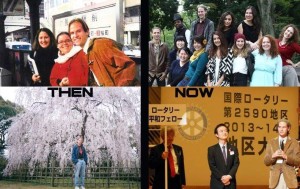
“In my experience, Japan is going through an interesting evolution these days. It’s starting to take a more assertive role in international affairs and taking more of a stand for human rights, development, and peaceful relations. This also makes it a very interesting time for Westerners to be engaged in Japan more than ever before.” (Courtesy of Cade Mosley)
By Mark Flanigan (Nagasaki-ken, 2000-04) for JQ magazine. Mark is a program director at the Japan ICU Foundation in New York City and was also a Rotary Peace Fellow at ICU from 2010-12, during which time he volunteered for a tsunami relief mission in Ishinomaki after the terrible 3/11 tragedy. In addition to his JET and Rotary service, Mark has also been a U.S. Army officer, Presidential Management Fellow, Pacific Forum CSIS Young Leader, Eisaku Sato Memorial Essay Contest prize winner, and Aspen Institute Socrates Program Seminar scholar. His interests lie in international education, disaster response, and post-conflict peacebuilding. He can be contacted at mflanigan[at]jicuf.org.
Christopher Cade Mosley (Nagasaki-ken, 2000-01) is a current Rotary Peace Fellow at International Christian University (ICU) in Tokyo and previously served as a JET for one year. Born in Texas and raised mostly in Fort Worth, Mosley attended the University of Texas at Austin, majoring in government and philosophy. He also spent a semester abroad in Haifa, Israel and interned for Congressional House Majority Leader Dick Armey in Washington, D.C. He was also on student government for their department (Liberal Arts), chairing the committee on study abroad. In this exclusive interview, JQ caught up with Mosley to discuss his lifelong interest in politics and international affairs.
Thanks for your time and for answering our questions, Cade! Would you please tell everyone about your time on JET?
I was a JET in 2000-01 on a long, thin island called Tsushima in Nagasaki, but physically closer to the city of Fukuoka, nestled in the strait between the cities of Pusan and Fukuoka. Tsushima is famous for a decisive sea battle Japan won against Russia in 1905 that first put Japan on the map as a world power and set its course into the 20th century. There’s a massive Russian battleship sunk just off the coast from my apartment there! (Too deep to see, though.) I taught for the second largest district, called Mitsushima, on the south end of the island.
What was your JET role?
I was an ALT at four schools in my district, spending a week in each so that I would rotate through all four in a month. I spent Monday through Thursday assisting the teacher with the lesson, usually coming up with some creative activity or role play to complement the lesson, and Fridays at our BOE.
Did you have any previous background in Asian languages and cultures?
I actually was accepted to JET while I was teaching English in Seoul, South Korea, and my friends there insisted I take the opportunity. Before Seoul, I didn’t have any experience. My whole reason for going to Seoul and applying to JET were because I had zero experience with Asia and thought it would be a good chance to get to know the region, since I was already interested in international affairs at that time.
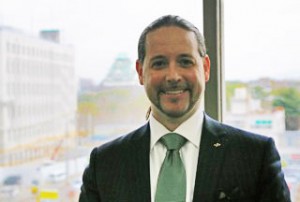
“I didn’t have any idea what I was getting into when I arrived as a JET, or if I would even be here longer than a couple of years. However, working for the future of these children, and trying to give them more opportunities in their future, has become my greatest personal accomplishment and given my life new meaning.” (Courtesy of Matthew Cook)
By Eden Law (Fukushima-ken, 2010-11) for JQ Magazine. Eden is a member of JETAA NSW, based in Sydney, Australia, which is part of the thriving JETAA Oceania community that covers Australia and New Zealand.
As a JET Programme success story, that of Matthew Cook (Osaka-fu, 2007-12)’s must surely rank as being one of the most extraordinary and inspiring. Hailing from Blacksburg, Virginia in the U.S., Matthew’s interest in Japanese martial arts led to his participation on JET. Beginning a five-year tenure as an in Osaka ALT, he also served as AJET national council chair, working with the Japanese government as well as JET alumni associations, international corporations, and news media about the value of the programme and internationalization. In 2012, after his JET tenure ended, he was hired by the Osaka Prefectural Board of Education as their Native English Teacher (NET) Program Coordinator, and in the following year, became a senior staff member appointed to the revolutionary English Education Reform Project—and as far as anyone knows, a first for a foreign-born, former JET to be appointed to a senior government role in education.
Now almost a year after his historic appointment, Matthew generously took some time out of his packed schedule to talk with JQ about his role, and most interestingly of all, provide some frank opinions about the JET Programme and the state and future of English education in Japan.
First of all, let me just say, congratulations on your achievement. In a nutshell, how did you go from being an ALT to a senior staff position at the Osaka Prefectural Board of Education? Is that something you could have imagined doing when you first arrived as a JET in 2007?
Thank you very much. It’s been a whirlwind, these past few years, and the congratulations are appreciated. However, we believe the real work is just beginning now.
During my time as a JET, I had the unique opportunity to develop my own curriculum and methodology, teaching junior high and elementary school students. I taught phonics part of a methodology, with the goal of extensive reading. I also had the honor being the AJET national council chair my final year on JET. That experience opened a lot of doors, allowing me to meet some influential people that I may not have been able to meet otherwise.
One of those people was Toru Nakahara, who was named the superintendent of the Osaka Prefectural Board of Education on April 1 of last year. He holds the strong belief that English education has been a failure in Japan, and wants to reform the system altogether. He was one of the first people to take my opinions and experiences seriously, and believed that I could use them to play a key role in the reformation of English education in Osaka. Because of that, I got the chance to interview for a position on his special “English Reform Project Team,” fondly referred to as the “Seven Samurai.”
It’s something I never would have dreamed of in 2007. In fact, I didn’t have any idea what I was getting into when I arrived as a JET, or if I would even be here longer than a couple of years. However, working for the future of these children, and trying to give them more opportunities in their future, has become my greatest personal accomplishment and given my life new meaning.
“Seven Samurai” is a wonderfully evocative name. Who are the other members on the English Reform Project Team?
I was hired from outside the board of education along with Kiyoshi Takeda, who was a high school English teacher in Shiga prefecture. He took a couple years off, and a few years ago he graduated from Harvard with a master’s in educational leadership.
Colleagues who already worked for the board education were teamed with us, because they should have a good understanding of the internal processes of the board of education. Two members from the high school division, two members from the prefectural education center, and one member from the elementary and junior high school division.
I know it’s early days yet, but what kind of impact does the appointment of a non-Japanese (and a former JET!) to a government position have on English education and the perception of JETs in particular?
That’s a tough question for me to answer. It’s a huge leap forward, and very encouraging from my viewpoint. I hope that it opens the door for other government entities in Japan to see what’s possible and search out capable employees with broader experience and different perspectives to add to their workplace. If there’s anything that I’ve learned, it’s that diversity should be celebrated and encouraged.
JQ Magazine: JETAA UK Launches Careers and Networking Programme
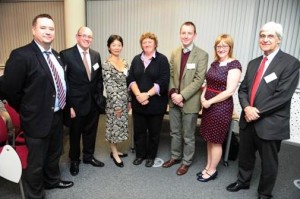
JETAA UK members Sarah Parsons (second from right) and Rob Gorton of Toyota (second from left) attend the inaugural Careers and Networking Programme reception with guests in the fields of business and academia, Nottingham, Oct. 3, 2013. (University of Nottingham)
By Sarah Parsons (Gunma-ken, 1995-97) for JQ magazine. Sarah is the careers and networking coordinator for JETAA UK and chair of the Midlands Chapter. She also runs her own business called Japan In Perspective, where she facilitates business links between the UK and Japan.
There are a variety of ex-JETs: those who have just returned looking for jobs and hoping to make sense of and use their JET experience, and those who are still interested in keeping in touch with Japan who have been very successful using their JET experience professionally—whether it be directly Japan-related or using it as a catalyst for a new career—but who have not been engaged with JETAA for a long time, if ever. Several things became evident.
First, JET can be a life-changing experience that offers so many potential professional opportunities, but the professional needs of our members are not being formally facilitated within JETAA UK. Secondly, the job environment in the UK is getting more and more competitive and it is very challenging for ex-JETs to stand out, gain more business skills and use their experiences professionally, so there is a demand for helping JETs with their post-Japan careers; and thirdly, in order to achieve any of this, JETAA needs to raise its profile professionally and engage with local business communities.
In this vein, we decided to map out a multifaceted programme within JETAA UK to facilitate these needs and to engage and utilise the expertise of some of our more experienced members. We wanted to organise networking events for local ex-JETs to meet the local business communities (UK companies that are interested in Japan as well as local Japanese companies) so as to offer great opportunities for JETs to develop important contacts and give attendees a chance to keep up to date on what is happening in the Japan-related business world.
JQ Magazine: JQ&A with Photographer Wei Yuet Wong on ‘The Fukushima Project’
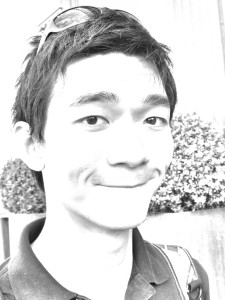
“Though people have told me no one wants to see disaster photos anymore, I think it’s a good reminder because it’s barely three years, and already people are forgetting. Not only outside Japan, but within Japan itself, people are forgetting. It’s true that people need to move on and rebuild their lives, but there’s still so much more work to be done in Tohoku.” (Courtesy of Wei Yuet Wong)
By Nathalie Ng (Shizuoka-ken, 2010-11) For JQ magazine. A member of JETAA Singapore, Nathalie was an inaka JET and her time in Japan has taught her to appreciate the flowers by the roadside and how to snowboard.
Wei Yuet Wong (Nagano-ken, 2008-10) left his home in Singapore to join JET following a summer homestay in Hiroshima. He went there because of the history as he’d learnt about the devastation during World War II, and he was particularly interested in seeing how the city had progressed since then. The relationship formed with his homestay family inspired him to join JET.
Assigned to three different schools in Ueda City, during his first few months he was often left feeling clueless and dependent on his supervisor due to the language barrier and the office hierarchy, but he soon got better at it by keeping an open mind and adapting. He is particularly proud that he was able to inspire in his students that they didn’t have to speak English with an American accent to be understood, and this has helped them to be more confident, speaking out during and outside of classes. (In fact, one of Wong’s former students even visited him and his family during the Chinese New Year.)
Since returning from Japan Wong has been working as a corporate warrior, but since last year he has finally taken the leap to pursue his photography interests. His work is now on display in a new exhibition called The Fukushima Project, which runs through 14th February at Select Books in Singapore on 51 Armenian Street. Through special postcards available for sale, visitors can write messages to the people of Hisanohama in Iwaki, which will then be collected and sent to them to let them know that their story has not been forgotten.
In this exclusive interview, JQ spoke with Wong about his visits to Fukushima before and after the 2011 Tohoku earthquake and tsunami, and the relationships he’s made with the locals through his numerous community activities.
You were posted to Nagano-ken and you lived there before the quake happened. What was your motivation for this exhibition?
I felt awed and hopeless when I first looked at the videos of the earthquake, perhaps like so many people around the world. Then why Fukushima? I think there may be three explanations. One, I first visited Fukushima in 2009 to visit friends, so I got to see Fukushima before the disaster. It was quite a different place.
Two, I have friends in Fukushima, and they live in Koriyama city, about 45 km away from the Fukushima No. 1 nuclear power plant. I was concerned about them. I was curious to know how they felt on the day of the earthquake, and then during the subsequent confusion about the nuclear power plant. I also wanted to see how they are doing when most other parts of the world, and Japan, starts forgetting about them.
Lastly, I wanted to experience how it would be like to venture into the disaster zone. I have a need to see things for myself. To touch the soil. Walk on the sand. Smell the salty air on the Japanese east coast, and try to imagine how people felt that day.
Why did you choose this particular town of Hisanohama?
It was by chance that I discovered this town. It’s quite a story, one thing leading to another, with some fortunate chance encounters. But, the best summary is: I met a friend at Koriyama Station to listen to her account, and her experiences. After that I wanted to visit the coast, so she told me that Iwaki is where I should go. With my ticket bought, I hopped on the bus for the 1.5 hour journey to Iwaki. Once at Iwaki, I went to the local tourist office, and asked for directions to the coast. The person at the office looked quite surprised, and she pulled out a map, studied it for a moment, and said, “Maybe you shouldn’t go. We used to have nice beaches, shrines, and attractions. But now, nani mo nai (there’s nothing).” I was not put off, and she finally realised that I would still go no matter what, and she suggested why don’t I go to Hisanohama, where I can have a nice walk, and just look around. So, there I went.
In the international media, most people know about Kesennuma, Rikuzentakata and Minamisoma, but Hisanohama remains unknown. So, I think it’s nice that I visited Hisanohama. It’s a town just 31 km south of the Fukushima No. 1 nuclear power plant, along the Pacific Coast, and has suffered great damage in the tsunami.
JQ Magazine: MIT Professor Ian Condry Explores ‘The Soul of Anime’
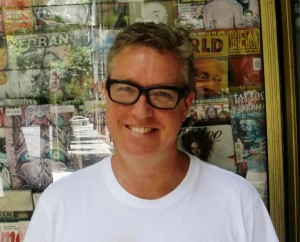
“I think it’s a challenge coming back from JET. But the times and experiences we had will really pay off in the long run even if in the short term it’s hard to see how they will apply.” (Courtesy of Web.mit.edu)
By Sheila Burt (Toyama-ken, 2010-12) for JQ magazine. Sheila is a Chicago-based journalist who blogs at www.sheilaburt.com.
Anime can easily be called a global phenomenon. In the past few decades, several anime TV series and movies have grown so successful that even people with little knowledge of Japanese culture can probably name at least one anime show or character. But how is something that is so labor intensive, costly and culturally quirky able to transcend oceans and inspire rabid fan bases?
A participant in the JETAA Regional Conference held at Harvard University earlier this month, cultural anthropologist Ian Condry (Miyagi-ken, 1988-89) explores this question in his new book, The Soul of Anime. An associate professor of comparative media studies at MIT since 2002, Condry researches cultural movements that go global, looking at how and why certain local phenomenon spread. The Soul of Anime is his second book, followed by Hip-Hop Japan: Rap and the Paths of Cultural Globalization (2006), about the inner world of Japanese hip-hop.
Although initially interested in the business model of anime, Condry changed the focus of his research after learning, rather surprisingly, that “No one gets rich making anime. And in fact, it’s a terrible business model.” Rather than looking at how anime sustains itself business-wise, Condry looks at the power of anime as a platform where, oftentimes, fans and other forms of “collaborative creativity” are at the heart of anime’s success. In order to illustrate this argument, Condry tells the story of Gundam, an anime series about giant robots that first aired in 1979. It was initially a ratings failure, but after fans created everything from encyclopedias to timelines about the show, it became a cult sensation, eventually becoming the longest-running anime series in Japanese history.
“If you look at media only in terms of the genius of the creators or the kind of business model that it fits into, then you miss the power of fans and the importance of the value they add to the products,” Condry explains. “That’s sort of what the book is about. I think now we’re starting to see that all over the place with Facebook, Wikipedia, and Twitter, all these kind of media platforms where the content is made by the users but then there’s this interaction between the users and the platform producers that make all the difference.”
JQ Magazine: North American Alumni Regional Conference Advances JETAA Initiative
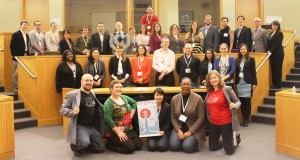
Delegates to the 2014 JETAA Regional Conference at the Edwin O. Reischauer Institute of Japanese Studies at Harvard University, Jan. 2014. (Courtesy of Tim Ogino)
By Tim Ogino (Akita-ken, 2011-13) for JQ magazine. Tim returned from Japan last summer and immediately became involved in NEJETAA as communications coordinator/webmaster. After spending two wonderful years in Tohoku, he returned to Boston to attend graduate school and is excited to remain involved with the Japanese community, looking forward to the day he can return to the land of festivals, kiritampo, and karaoke.
With New Year’s goals and resolutions firmly prepared, 34 JETAA delegates from 15 chapters across North America gathered for the 2014 JETAA Regional Conference at the Edwin O. Reischauer Institute of Japanese Studies at Harvard University in Cambridge, MA from Jan. 10-12 to discuss ways to improve their JETAA chapters. The New England JETAA chapter played host to this year’s conference and organized a series of discussions, workshops, and seminars under the theme of “Membership Management.”
The week preceding the conference was filled with anticipation about not only the content of the seminars and workshops, but also the weather in Boston. Stories about the week’s now infamous “polar-vortex” surely were intimidating to JET Alumni from warmer climates. Luckily, the temperatures recovered just in time for a comfortable and productive weekend for all in attendance.
The conference began on Friday night with a welcome reception graciously hosted by the Consul General of Japan in Boston, Akira Muto, which featured special guests Museum of Fine Arts Curator Dr. Anne Nishimura Morse and founding JETAA member Professor Ian Condry (Miyagi-ken, 1988-89) of MIT. Their kind remarks emphasized the importance of membership in JETAA as well as the presence of Japanese culture and art in America, setting an ambitious tone for the rest of the weekend.
JQ Magazine: Film Review—Hirokazu Kore-eda’s ‘Like Father, Like Son’
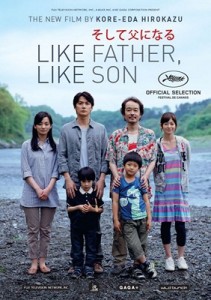
“As in his other films, Kore-eda’s action unfolds in minute detail and slowly evolving scenes. His static camera and well-balanced visual frame reference Ozu, another director concerned with Japan’s modernization and the traditional family.” (© 2013 FUJI TELEVISION NETWORK, INC.AMUSE INC.GAGA CORPORATION. All rights reserved.)
By Lyle Sylvander (Yokohama-shi, 2001-02) for JQ magazine. Lyle has completed a master’s program at the School of International and Public Affairs at Columbia University and has been writing for the JET Alumni Association of New York since 2004. He is also the goalkeeper for FC Japan, a New York City-based soccer team.
The winner of the Jury Prize at the 2013 Cannes Film Festival, Hirokazu Kore-eda’s newest film, Like Father, Like Son, features a stronger narrative arc and story than his previous films, which include the metaphysically philosophical After Life and the naturalistic Ozu-like Nobody Knows. In fact, the film’s plot reads like a Hollywood high-concept pitch: two families discover that their children are not their own due to a switch at birth. Developing a “nature vs. nurture”-type approach to the subject, Kore-eda gives the families different socioeconomic backgrounds.
Ryota Nonomiya (Masaharu Fukuyama) is a high-achieving architect who lives in a modern Tokyo high-rise apartment with his wife Midori and their six-year-old son Keita (Keita Ninomiya). The other father, Yudai Saiki (Lily Franky), is a working class shopkeeper who lives on the outskirts of the city in a nondescript housing block with his wife Yukari (Yoko Maki) and the young Ryusei (Hwang Sho-gen). By presenting these two disparate backgrounds, Kore-eda examines the nature of father-son relationships and familial influence in modern Japan.
Much of the film’s action concerns the responses to the shocking new information. Do the families try and “switch” the children again so that the original wrong can be corrected? Now that they are inseparably involved in each others’ lives, do they try and raise the children together? Or do they simply carry on as before, complicit in their knowledge that neither child is living with his biological parents? Kore-eda examines each of these scenarios as the characters try to confront a situation that life has not prepared them for.
JQ Magazine: Tohoku Projects—The TOMODACHI Initiative

Suzanne Basalla, left, presents The TOMODACHI Generation: Investing in the NEXT Generation of U.S – Japan Relations, Chicago, Oct. 11, 2013. (Sheila Burt)
By Sheila Burt (Toyama-ken, 2010-12) for JQ magazine. As part of an occasional series, Sheila is profiling individuals who are or were in some way involved with rebuilding efforts in the Tohoku region. Her first post was on the writing project 3,000 Letters to Japan. After JET, Burt spent an additional year in Japan working at a private school and translation company. She recently returned to the Chicago area. Read more of her reporting at her blog, Stories from the Inaka.
Having been posted in Tokyo during the disastrous March 11 earthquake and tsunami of 2011, diplomat Suzanne Basalla saw firsthand how quickly Japan changed in a matter of seconds.
As senior advisor to former Ambassador John V. Roos in the Embassy of the United States in Tokyo, Basalla had been living in Japan since March 2010, advising Roos on several economic and foreign policy matters. A few months after 3/11, Basalla visited Tohoku and started thinking of ways to encourage redevelopment in the stricken area, “trying to do what we [could] to create hope and support,” she recalled. Although her post with the embassy ended in March 2012, she realized she wasn’t ready to go back to the Pentagon.
Instead, Basalla and a team of others pooled their efforts to create the TOMODACHI Initiative, a public-private partnership established in the wake of 3/11 with the U.S.-Japan Council in Washington. TOMODACHI helps coordinate educational, business and cultural exchange programs for Japanese youth, particularly students in Tohoku, where development opportunities are still few and far between. Presenting at a Japan American Society of Chicago event last October, Basalla referred to TOMODACHI as “an incredibly important initiative…with a path-breaking paradigm.”
“Part of leadership is getting to know yourself,” said Basalla, who now serves as executive vice president of the U.S.-Japan Council. “TOMODACHI’s initiative is to inspire and empower young Japanese and Americans by giving them experience, skills and confidence to achieve their dreams and contribute to a better world.”
JQ Magazine: Manga Review — ‘Showa 1926-1939: A History of Japan’

“If you enjoy or are interested in manga, history and yokai, or if you appreciate excellent works such as Barefoot Gen and Maus, then Showa 1926-1939: A History of Japan and the rest of the series is a must-read.” (Drawn and Quarterly)
By Julio Perez Jr. (Kyoto-shi, 2011-13) for JQ magazine. A bibliophile, writer, translator, and graduate from Columbia University, Julio is currently seeking opportunities with publications in New York. You can follow his enthusiasm for Japan, literature, and board gaming on Twitter @brittlejules.
Shigeru Mizuki is a world-famous manga artist and writer best known for his work on yokai, which deals with Japanese ghosts, monsters and supernatural stories. He is the creator of Ge Ge Ge no Kitaro, his most famous work about yokai, and he is also well known and respected in Japan for his autobiographical work about growing up and serving as as a soldier in World War II-era Japan. He created a well researched historical and autobiographical manga about the Showa period which received the Kodansha Manga Award in 1990 and is now being published in English by Drawn and Quarterly. The first of four volumes, Showa 1926-1939: A History of Japan, was translated by JET alum Zack Davisson (Nara-ken, 2001-04; Osaka-shi, 2004-06) and released last November. (For more on Davisson, read our exclusive JQ interview with him here.)
This illustrated history of Japan is praised for its accuracy in portraying the atrocities of the Japanese military during the Pacific War while also showing how the Japanese people themselves suffered on the home front. At 91 years old today, Mizuki has given us a complete and accurate account of an entire age that few alive today remember and that the rest never knew firsthand. The story is an important and valuable resource meant for generations of people who have not experienced the chaos of war and the despair of starvation. The manga is very much meant to educate the next generation of Japanese children about the controversial and darker parts of their history and to serve as a cautionary tale to remember in times of peace. It does not sugarcoat anything, and gives great insight into the tensions between Japan and China, North and South Korea, and other countries in Asia that persist today.
JQ Magazine: Hark! The Herald KFC
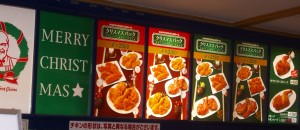
Good tidings we bring for you and your kin /
Good tidings for chicken and a happy new year. (Jarrad Skinner)
By Jarrad Skinner (Toyama-ken, 2007-11) for JQ magazine. Jarrad is an instructional designer for interactive online courses in the mental health field. Otherwise, he’s obsessed with game design, comedy, and hip-hop. After being born on Long Island, educated in Manhattan, and confused in Japan, he lives in Brooklyn. You can find him on the dance floor.
It’s Christmas Eve and KFC is out of chicken. This can’t be life. We didn’t make reservations, so we can’t have any chicken. It’s one thing to walk into KFC on Christmas Eve to get a bucket of greasy poultry parts, but it’s a whole other indignity to be told you can’t have any. Biscuits and sides will have to do.
As many of you probably already know, KFC pulled off some kind of unholy cross-cultural coup to convince a good portion of Japan that KFC and Christmas go together like peanut butter and jelly. Well, that is, if you’re American, PB&J go together naturally. And that’s really the point that I had to stubbornly learn again and again in Japan: nothing naturally goes with anything. We make it up as we go and then get used to our inventions. We become so used to them, we call them natural or traditional or don’t call them anything at all because we take them for granted like pizza with tuna fish topping.
If there’s one thing we take for granted more than readily available pairings of foods, it’s family. You might be a jackass today, but you expect family to be there tomorrow anyway. And if there’s one message that’s been drilled into our heads by the seasonal onslaught of holiday songs and shows, it’s “Go home to your family!” Every memory of every sitcom holiday special featuring some selfish oaf learning the lesson that the real present at Christmas is family reminds me that as the holidays approach in Japan I feel…unnatural.
JQ Magazine: The Steady Riser – A Conversation with Tokyo Musician Nelson Babin-Coy

“The Japanese market is a very unique market; it’s very closed. It is kind of frustrating when I try to introduce Western ideals in my music or introduce how I feel live music should be enjoyed at gigs or live venues. If you want to dance, dance. If you want to move, move.” (Lisa (paint with stars) www.paintwithstars.com)
By Sheila Burt (Toyama-ken, 20010-12) for JQ magazine. Sheila recently returned to America after living in Japan for three years (two years in Namerikawa with JET and one year at a private school in Ehime-ken). She is currently looking for a job and welcomes all leads. View more of her work at www.sheilaburt.com.
The first time Tokyo-based musician Nelson Babin-Coy visited Japan, he was a 15-year-old high school student from the suburbs of L.A. who knew next to nothing about Japan. Interested in learning more about Japanese music during his stay in Gunma Prefecture, he started listening to what other teenagers his age were into, including the idol group Morning Musume. Yet when he first heard one of the band’s songs, he cringed a bit. “I wasn’t disgusted, but I was like, ‘This is music in Japan?’,” he laughs.
Thankfully, his host sister introduced him to the Battle Royale theme song by Dragon Ash, and he was hooked. The two weeks Babin-Coy spent in Gunma were enough to give him a new dream to follow. He wanted to live in Japan, though he had yet to figure out the how and what to do.
“I love Japanese music and lyrics,” he says. “I think Japanese artists are more artistic in the way they form their stories.”
Now 28, Babin-Coy is a rising singer-songwriter who primarily sings in Japanese and works with several native artists trying to break into the Western market. He has toured the mainland three times with his band, nothing ever lasts (currently on hiatus).
JQ Magazine: JQ&A with Manga Translator Zack Davisson on Shigeru Mizuki
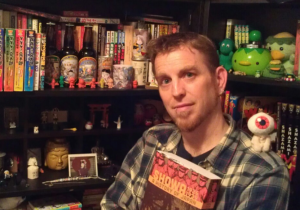
“All of JET is fond memories for me. I loved it. Kansai was the perfect area. Nara, Osaka, and Kyoto were all in easy reach so I had the best of everything. I lived in ancient and traditional Japan, but had wild and modern Japan nearby anytime I wanted. I did everything I could possibly do, went everywhere, tried everything—it changed my life.” (Courtesy of Zack Davisson)
By Julio Perez Jr. (Kyoto-shi, 2011-13) for JQ magazine. A bibliophile, writer, translator, and graduate from Columbia University, Julio is currently seeking opportunities with publications in New York. You can follow his enthusiasm for Japan, literature, and board gaming on Twitter @brittlejules.
A scholar, author and translator of Japanese folklore and ghost stories, Zack Davisson (Nara-ken, 2001-04; Osaka-shi, 2004-06) joined the JET Program in 2001 with some basic Japanese knowledge and a strong desire to learn much more. After spending five years on the program, he remained in Japan to acquire a master’s degree in Japanese studies while writing freelance and translating for Osaka University.
The theme of Japanese ghosts running through Davisson’s writing and translation dovetails the interests of manga legend Shigeru Mizuki, who is famous for the classic series GeGeGe no Kitaro. Mizuki is equally well known in Japan for his autobiographical works about his experiences as a soldier during World War II. A great fan of Mizuki, Davisson now contributes to publisher Drawn and Quarterly’s English adaptations of Kitaro and is the translator of the first volume of Mizuki’s historical manga Showa 1926-1939: A History of Japan, released last month in North America.
In this exclusive, expansive interview, Davisson discusses his time on JET, the significance of Mizuki’s supernatural and historical works, and the unique methods and madness of manga translation.
How did you first become interested in learning the Japanese language, and how long have you been studying it? For aspiring translators who are still studying, do you have any advice about textbooks, programs, or techniques?
I actually became interested when I was about 10 years old and my mother took me to see Seven Samurai at a local art theater. I was hooked pretty early—if I you look at my class pictures from that time I am wearing ridiculous Japan t-shirts. I took Japanese in high school when it was offered as a foreign language, but there were only four of us in the class, so it was cancelled—no one was interested in learning Japanese back then. This was the ’80s, so there was no “Cool Japan.” That pretty much ended my language studies for a while.
Decades later when I went on JET, I was useless language-wise. I thought I knew more Japanese than I did, but really just the set phrases and greetings. I was determined to leave JET functionally bilingual, so I just studied as hard as I could from day one, eventually getting my master’s degree in Japan.
My only real advice for people is to go to Japan, and talk and read and practice as much as humanly possible. There is no substitute for immersion and experience. I always say I learned more Japanese at my local bar, the 100 Club, than I did doing my MA. Talk, talk, talk. Read, read, read. Use Japanese as a living language, don’t just study it as an abstract. And, of course, marry a Japanese person. That’s a huge advantage!
When and where were you posted for JET? Could you talk a bit about your time there and what you remember fondly?
I started JET in…I think 2001. Crazy to think it was more than 10 years ago, because it doesn’t feel that way. I was unusual in that I was a 5-year JET that worked in two prefectures. I did three years in Nara and then two years in Osaka. I don’t know if they still allow you to do that. I was one of the first in my prefecture to get that contract extension, and even then there were only two of us allowed to do it.
As for fond memories…all of JET is fond memories for me. I loved it. Kansai was the perfect area. Nara, Osaka, and Kyoto were all in easy reach so I had the best of everything. I lived in ancient and traditional Japan, but had wild and modern Japan nearby anytime I wanted. I did everything I could possibly do, went everywhere, tried everything—it changed my life. And my career; I got started in writing and translating doing articles for my prefectural newsletter, then moved on to publishing magazine articles for Kansai Time Out and Japanzine. And now I have my Shigeru Mizuki translations out and my book, Yurei: The Japanese Ghost, coming next year. I owe all that to JET and the people I met on JET.
In what ways did you become involved in your community?
I wasn’t a big community person, other than I threw myself into every matsuri I could. I was fascinated with Shinto festivals, especially the big, loud, and dangerous ones. Anything fueled with alcohol and adrenaline. I did the Okayama Hadaka Matsuri four times and brought the magic sticks out twice. I carried this massive mikoshi in a little village in Nara every year. In Osaka, I carried these giant, flaming torches in the Taimatsu Matsuri for my town. I loved the primal nature of these matsuri, the physicality and closeness to the gods—it’s something we’ve completely lost in the U.S. In our quest for safety and comfort we’ve lost something intangible. Something Joseph Campbell would have recognized and appreciated.
Other than that, I was a regular at a local bar, the 100 Club in Osaka. A different kind of community, but that was another life changer. I’m still friends with my pals from the 100 Club and we even got matching tattoos. Not quite as sweet as volunteering at the local children’s eikaiwa, but there it is.
JQ Magazine: Book Review – ‘Life in Japan: The First Year’
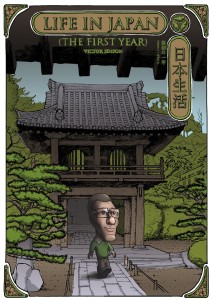
“Edison’s artistic talent captures Japan’s essence and his autobiographical account is honest and direct. JET Alumni will be able to follow his story and find many of their own experiences and thoughts represented within his work. From his first encounter ordering a hamburger to his dissatisfaction with being a glorified babysitter, his tone and pace keeps the reader hooked.” (Big Ugly Robot Publishing)
By Lana Kitcher (Yamanashi-ken, 2010-12) for JQ magazine. Lana is the business development associate for Bridges to Japan. To read more about Lana’s adventures in Japan and New York, visit her blog at Kitcher’s Café.
Victor Edison is a young man who remembers always having some Japanese influences present throughout his life. His family hosted a Japanese exchange student during his childhood, and he was fascinated by anime and manga from a young age. After graduation he found himself working a job he didn’t really want that wasn’t really going anywhere. A friend that was working in Japan at the time encouraged him to apply to be an English teacher and all he could respond to this was, “why not?”
Published by Nagoya-based Big Ugly Robot Press, Life in Japan: The First Year is a bilingual graphic novel written and drawn by Edison about his first year working for an English language school in Mie Prefecture. With little previous knowledge of the Japanese language or customs, he travels blindly to his new home armed only with his enthusiasm and determination to succeed, his ultimate goal to one day become a full-time artist.
His first choice was to work in Tokyo, simply because that was all he knew. After his interview with “Noba,” he soon learns that he has been offered a position in Mie, and accepts.
He starts work at an English conversation school located in a semi-rural area. While the majority of the clients were adults and young adults, the teachers often had to “teach” toddler classes as well. Because the school was located in a shopping mall, many parents would drop their kids off at the English school to fit in some uninterrupted shopping time. The teachers quickly learned that the child classes were thinly disguised babysitting sessions.
JQ Magazine: 2013 JETAA Oceania National Conference Spotlights Sister City Relationships
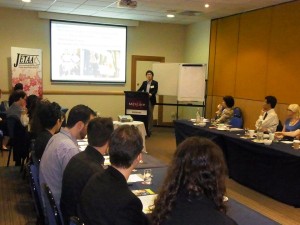
Hiromi Hakuta, assistant director of CLAIR Sydney, addresses alumni at the JETAA Oceania National Conference, Brisbane, Nov. 2013. (Courtesy of Hiromi Hakuta)
By Eden Law (Fukushima-ken, 2010-11). After the JET Programme more than fulfilled its promise of “an experience of a lifetime,” Eden returned to Sydney, Australia, where he joined the JETAA New South Wales chapter to take advantage of the network and connections available to undertake projects such as an uchiwa design competition for the Sydney Japan Festival. He also maintains the JETAANSW website and social media. Other than that, he’s a web designer and a poet, gentlemen and raconteur.
One of the best things about being a member of JETAA is the community, and over the weekend of 15-17 of November, the Oceania community of JETAA got together for our annual antipodean regional conference. For those of you up north who don’t know, JETAA Oceania comprises of five Australian chapters (the state chapters of Queensland, New South Wales, Canberra, the uber-chapter of South Australia-Victoria-Tasmania, Western Australia) and three New Zealand chapters (South Island, Auckland and Wellington). Representatives from Sydney’s CLAIR office (Tsuyoshi Ito, Hiromi Hakuta and Julien Ansart) attended as observers of the proceedings. This year, JETAA Queensland played host in Brisbane, the northern capital that looks to Asia and is close to the Gold Coast, a favoured destination for young Japanese looking for sun, surf and sand. Appropriately, we had our first lunch meet on Friday at MOS Burger, the famous Japanese fast food chain whose only non-Asian presence internationally is right in Brisbane.
JETAA Oceania was invited to attend the Welcome Back Reception for returning JETs at the Japanese Consul General’s home in Brisbane on the Friday night, a chance of course for us to network and hobnob with the cream of Brisbane’s Japanese cultural community. And after the reception finished (early, predictably), JETAA kicked on in town for a night out (hint: it’ll always involve karaoke—usually lots of obscure Japanese songs sung by that one quiet serious person who turns into a blurry, hip-thrusting maniac).
The first day of the conference began on Saturday, early (for some, too early) at our hotel and Laura Tasharofi, president of JETAA Qld, began proceedings by explaining the theme of this year: Australia-Japan sister-city relationships. As explained by Hakuta-san, of all countries, Japan has the most links in Oceania, with 108 sister city relationships in Australia and 44 in New Zealand. Therefore, the potential for JETAA to get involved is great, and the conference’s objective is to find ways to participate and be more prominent in our local communities. To start discussions and provide ideas and examples, two guest speakers, Ross Humphreys and Barry Hancock, were invited who are respected members of the Brisbane community and its influential sister city relationships.
JQ Magazine: JETAA USA Earthquake Relief Fund Aids Recovery
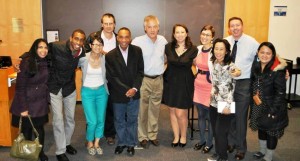
Taylor Anderson Memorial Fund founder Andy Anderson (center) with members of the JET Alumni Association of New York at Columbia University, Oct. 30, 2013. (Courtesy of JETAA New York)
By C-M Daeley (Saga-ken, 2008-2011) for JQ magazine. C-M is a poet, rap lyricist, and travel enthusiast currently working as an English teacher in Tokyo. For a look at some of his other writing, poetry and lyrics, check out his blog at http://spikedaeley.wordpress.com.
With today’s 24-hour global news cycle, it is sometimes difficult to keep even the most severe events in public memory. The Great East Japan Earthquake that struck on March 11, 2011 has not received much recent coverage in global news, but the issues faced by those still rebuilding remain monumental. Fortunately, there has been significant international aid from a number of sources, one of which is the JETAA USA Earthquake Relief Fund. This grant has raised almost USD $90,000 and has been used to provide seed funding to assist grassroots programs in areas severely impacted by the earthquake.
Due to the complex nature of fund allocation, this article will focus mainly on projects and programs directly supported through JETAA funds. However, it is significant to note that the Earthquake Relief Fund was only one of several avenues used to bring aid to the region and that, to date, roughly $500,000 has been raised through JET-affiliated groups and organizations worldwide. Jim Gannon (Ehime-Ken, 1992-94), current executive director at the Japan Center for International Exchange in New York, and Jessyca Livingston (Hokkaido, 2003-06), one of the three JETAA USA Country Representatives serving during the immediate aftermath and current JET Program coordinator at the Consulate-General of Japan in Denver, spoke about some of the initiatives the Earthquake Relief Fund has helped support.
“It is very difficult to give a concise yet comprehensive picture of what the JETAA funds have done,” Gannon explained. “The best way to describe it is that they have played a catalytic role in supporting some key projects in the early stage that have been supported by a range of others in more generous fashion once they proved their merits. JETAA cannot take full credit for all of the successes, but it did play an important role in getting things moving.” He also noted, “The real heroes are these incredible people from Tohoku who have championed these projects, the inspirational young people who have relocated to Tohoku to help operate them, and those who have been shuttling back and forth from Tokyo and elsewhere to help formulate and drive these initiatives.”
After a national discussion and several rounds of voting in each of JETAA USA’s 19 chapters, a final decision was made about how the fund should be allocated. “In the end, it was very obvious that chapters found it important to support education-related efforts in those areas most affected,” Livingston said.

